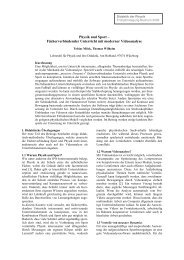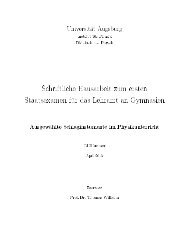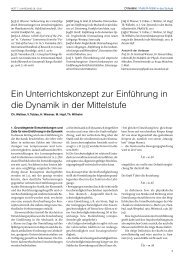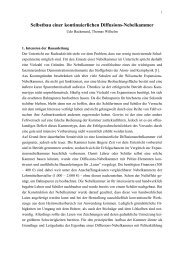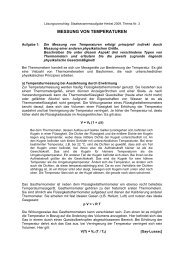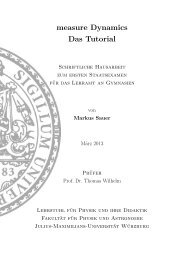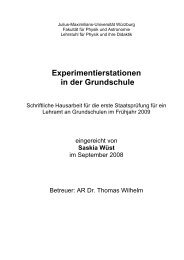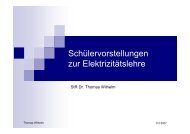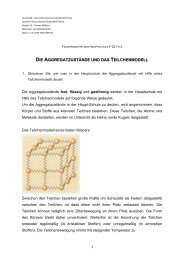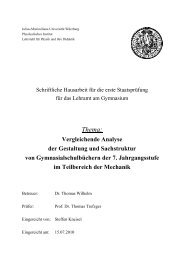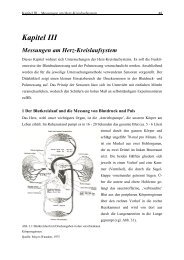Konzeption und Evaluation eines Kinematik/Dynamik-Lehrgangs zur ...
Konzeption und Evaluation eines Kinematik/Dynamik-Lehrgangs zur ...
Konzeption und Evaluation eines Kinematik/Dynamik-Lehrgangs zur ...
Sie wollen auch ein ePaper? Erhöhen Sie die Reichweite Ihrer Titel.
YUMPU macht aus Druck-PDFs automatisch weboptimierte ePaper, die Google liebt.
262 9 Abstract<br />
tion is totally different. In this case, the problems are merely solved by an average of 12 % of students<br />
at the beginning of 11 th grade (n = 373), whereas an average of 71 % give answers as if velocity<br />
had been asked for (chapter 6.4.2.3). After traditional instruction, 47 % of the students on average<br />
answer correctly (n = 188), and 37 % answer as if velocity has been asked for. In case of motions<br />
to the left, an average of 7 % answer as if acceleration were the change of the magnitude of<br />
velocity (“+” = speeding up, “-” = slowing down). Items with motions to the right are solved correctly<br />
more often than items with motions to the left. Within one direction of motion, items with<br />
motions at constant velocity are answered correctly most frequently, followed by items with speeding<br />
up motions, whereas items with slowing down motions yielded the worst results (chapter<br />
6.4.2.3).<br />
A problem regarding the acceleration when tossing a coin vertically up into the air, for which the<br />
algebraic sign for the acceleration with a given coordinate system had to be indicated, produced<br />
similar results. After instruction, only 7 % of the students (n = 188) give the correct answer for all<br />
three phases (upwards, up, downwards), another 10 % at least for the upward phase and the downward<br />
phase (chapter 6.4.3.1). 36 % of the students give an answer regarding the change of the magnitude<br />
of velocity; the task of drawing an arrow for the direction is a problem for many of these<br />
students. 41 % give an answer pertinent to velocity instead of acceleration (chapter 6.4.3.1).<br />
Thus it can be said that in the cases of both types of problems regarding acceleration (graphs and<br />
coin toss) approx. 40 % of the students give answers pertinent to velocity, and approx. 50 % showed<br />
a certain degree of <strong>und</strong>erstanding of acceleration, but often only regarding to the change of the mag-<br />
�<br />
nitude of velocity a = ∆ v / ∆t<br />
.<br />
Finally problems were set according to which the acceleration had to be given as an arrow only,<br />
with no coordinates system being defined, so that the students could not give “+” for speeding up<br />
and “-” for slowing down. After mechanics instruction, approximately 90 % of the students provide<br />
a correct solution for motions along a straight line (n = 217), whereas only an average of 9 % give<br />
the correct solution for motions along a curved path (at constant speed, speeding up, and slowing<br />
down) (chapter 6.4.1.1). In contrast, an average of 59 % give an arrow representing more or less the<br />
tangential acceleration (possibly curved arrow), whereas it can be assumed that often the conception<br />
of “speeding up/slowing down” was illustrated with arrows.<br />
All in all, the conclusion can be drawn that in traditional instruction, only few students achieve a<br />
physically adequate <strong>und</strong>erstanding of acceleration, enabling them to solve problems on acceleration<br />
consequently correctly, also in case of change of direction or two-dimensional cases.<br />
In contrast to the US, in Germany only few classes and a large number of university students have<br />
done the established FCI test on the physical concept of force up to now, whereas this test has been<br />
done for the first time by a larger number of students within the framework of this test (first version<br />
of the test). At the beginning of 11 th grade, the students solve 28 % of the 29 qualitative items correctly,<br />
and 41 % after mechanics instruction (n = 258), which makes up a normalized gain (= ratio<br />
of average gain to maximum possible average gain) of only 18 % (chapter 6.5.1.2). There are especially<br />
low normalized gains with the subscales “Newton’s Second Law” and “superposition”. Here




